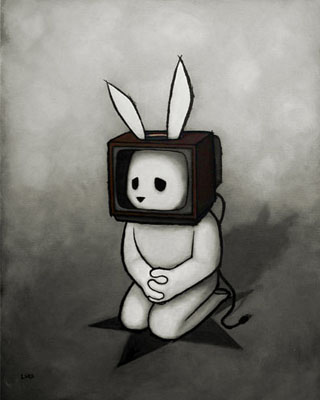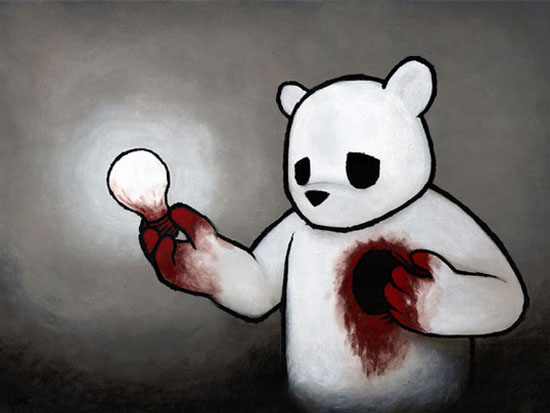SpearTalks: Luke Chueh

"Sure we've never been bears, but that doesn't mean we've never loved one," says Luke Chueh, the man behind some of today's more recognizable pop-surrealist paintings. That's one way that the SF-based artist tries to explain the world's growing affinity for his toy-inspired work, and it may very well be the most significant. Of course, the fact that our eyes are so readily drawn to these paintings has as much to do with the subject’s masochistically demolished appendages as it’s place in our childhoods, but maybe that's why we owe Luke so much credit. Yes, the plots are dismal, but it's the familiar characters that catch our attention — and whether it's the blood or the bunnies that keep it, the fact remains that the canvases of Chueh might represent a unexpected truth. Read on as we chat with Luke about revelations, evolutions, and all the beheadings in between.
 JoshSpear.com: Your painting really emerged as a time-killer while trying to find a "real" job. Most other people just like to drink during this period – so what was it about painting that did it for you?
JoshSpear.com: Your painting really emerged as a time-killer while trying to find a "real" job. Most other people just like to drink during this period – so what was it about painting that did it for you?
Luke Chueh: When I said that I was painting to kill time, what I meant was that I was painting and showing at Cannibal Flower’s monthly art shows while looking for a job. Fortunately Cannibal Flower helped me develop and a name and a voice, giving me the exposure needed to eventually convince a gallery to take a chance on me.
I’m not one of those “I can’t live unless I’m painting” people. I waste time the same way just about everyone else does. But I do doodle in my sketchbook all the time though.
JS: Your paintings often tell the story of some sort of revelation, like the subjects are making a small, and sometimes morbid, discovery. Can you tell us about the element of philosophy in your work?
LC: Hmmm….I’m not sure what to say. I usually describe these “revelations” as being “innocence lost.” I simply combine light elements (a cute/toyesque animal) with dark elements (a shit situation). This formula also works the other way as well.
JS: You have a wide range of influences, yet your style is decidedly your own. What inspires you in the styles of the painters you love so much?
LC: I feel that the feel and attitude of those artists stimulate me the most. When I see their work evolve between shows, their growth excites me, and urges me to push myself. Of course I can also be inspired stylistically by an artist's paintings, but I can’t specifically point out any examples.
 JS: What I love most about lowbrow art is that, in general, and for reasons that are hard to define, it's incredibly emotional. We've never been bears with a bloody, gaping holes in our chests, but we feel it. Do you have a better grasp of the reason people react so strongly to this genre?
JS: What I love most about lowbrow art is that, in general, and for reasons that are hard to define, it's incredibly emotional. We've never been bears with a bloody, gaping holes in our chests, but we feel it. Do you have a better grasp of the reason people react so strongly to this genre?
LC: As a genre, I think the reason why lowbrow evokes an emotional response is because the work is generally figurative and driven by a clever narrative.
As for my own work, I think one of the possibilities why my audience empathizes with my bears is because as children we grew up and bonded with toys such as teddy bears and the like. Sure we’ve never been bears, but that doesn’t mean we never loved one.
JS: You've been quoted as saying that if art isn't challenging, from the viewers perspective, it's not really relevant. What challenges do you hope to present to viewers with your work?
LC: When I said “challenging” (within the context of what I was originally talking about) I was talking in terms of the artist creating the work. To work outside of their comfort zones. Simply creating abstract expressionist art in the same vein of Pollock and Rothko in this day and age is bullshit. Don’t get me wrong, I’m a big fans of both of those artists, it’s just that any one can paint a canvas blue, and splatter orange on it. I think it’s lazy and uninspired.
How am I challenging myself? Well, I’m a self-taught painter, and with each painting I try to push myself. When I started, I sometimes used pencil lead to create shading. In time, I taught myself how to blend paints so I wouldn’t have to “cheat” like I was in the beginning.
Lately, I’ve been rattling my brain over how my work was going to evolve. I sometimes feel that I’ve become too predictable. I need to push myself outside of the compositions I comfortable with, and work outside of my comfort zone. I don’t have an answer to how I am going to deal with this, but we’ll see how things develop with time.

JS: Your work, at its most basic, is fairly consistent "“ the subjects, color palate, and the concept of chimerical/cynical never seem to change that drastically. However, you still manage to keep doling out new interpretations of the same concept. Do you spend an increasingly long amount of time brainstorming these days?
LC: A lot of my ideas feel like they materialize out of nowhere. I’ll be watching television, or reading a book, and suddenly, “poof”, an idea pops in head. It could be inspired by what I was originally watching or reading, but most of the time it has nothing to do with these things. I don’t know… I think each painting I create is the amalgam of all the previous painting I’ve created.
JS: The scene for pop-surrealism/lowbrow art has been progressing pretty rapidly these past several years. Aside from the growth of its popularity, how would you say it has developed?
LC: Living in the epicenter of the genre, its growth has been as exciting as much as it has also been numbing. Artists are practically spewing out of the wood-work while galleries have sprouted throughout Southern California. The result: a big pop surrealist BLUR. It’s exciting time to be in Los Angeles, especially if you’re into this style of art.
JS: Do you experience a lot of off-beat reactions to your paintings?
LC: I think all artists experience “off-beat reactions” to their work. Regardless, I’m just happy that my work evokes a reaction from my audience.
JS: Your work has always portrayed a similar set of characters; bears, bunnies, etc. Will they be joined by any new animals in your upcoming paintings?
LC: I’m definitely want to expand on my universe, but we’ll see how it goes. One of my latest shows, “She’s my Heroin(e)” was my attempt to incorporate more female characters in my work.
JS: You did an interview with Fecal Face in 2006, and one of the last questions they asked you was "What will a Luke Chueh painting look like in 2009?" Your talent has definitely evolved since then, and now that we're closer to that year, how would you answer that same question?
LC: I’d say that my paintings will most likely look similar to what I’ve been creating now, but maybe technically tighter. I also think some of these paintings will feature me an attempting to push the stylistic boundaries typical of my paintings.
